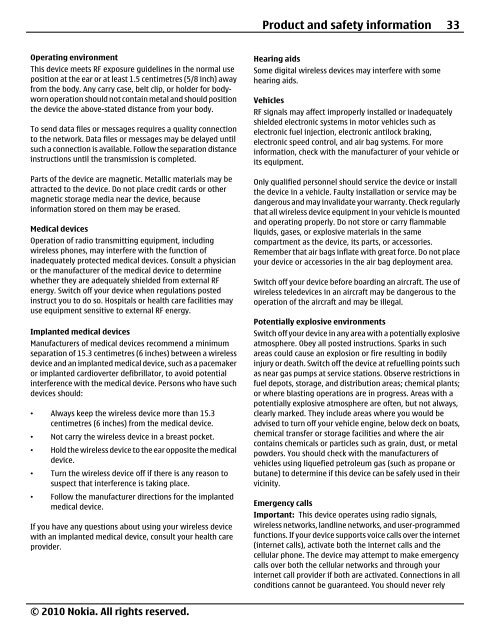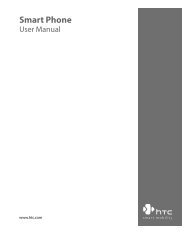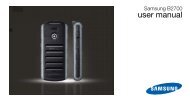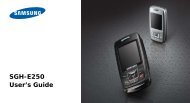Nokia C3â00 User Guide - Belsimpel.nl
Nokia C3â00 User Guide - Belsimpel.nl
Nokia C3â00 User Guide - Belsimpel.nl
You also want an ePaper? Increase the reach of your titles
YUMPU automatically turns print PDFs into web optimized ePapers that Google loves.
Product and safety information 33<br />
Operating environment<br />
This device meets RF exposure guidelines in the normal use<br />
position at the ear or at least 1.5 centimetres (5/8 inch) away<br />
from the body. Any carry case, belt clip, or holder for bodyworn<br />
operation should not contain metal and should position<br />
the device the above-stated distance from your body.<br />
To send data files or messages requires a quality connection<br />
to the network. Data files or messages may be delayed until<br />
such a connection is available. Follow the separation distance<br />
instructions until the transmission is completed.<br />
Parts of the device are magnetic. Metallic materials may be<br />
attracted to the device. Do not place credit cards or other<br />
magnetic storage media near the device, because<br />
information stored on them may be erased.<br />
Medical devices<br />
Operation of radio transmitting equipment, including<br />
wireless phones, may interfere with the function of<br />
inadequately protected medical devices. Consult a physician<br />
or the manufacturer of the medical device to determine<br />
whether they are adequately shielded from external RF<br />
energy. Switch off your device when regulations posted<br />
instruct you to do so. Hospitals or health care facilities may<br />
use equipment sensitive to external RF energy.<br />
Implanted medical devices<br />
Manufacturers of medical devices recommend a minimum<br />
separation of 15.3 centimetres (6 inches) between a wireless<br />
device and an implanted medical device, such as a pacemaker<br />
or implanted cardioverter defibrillator, to avoid potential<br />
interference with the medical device. Persons who have such<br />
devices should:<br />
• Always keep the wireless device more than 15.3<br />
centimetres (6 inches) from the medical device.<br />
• Not carry the wireless device in a breast pocket.<br />
• Hold the wireless device to the ear opposite the medical<br />
device.<br />
• Turn the wireless device off if there is any reason to<br />
suspect that interference is taking place.<br />
• Follow the manufacturer directions for the implanted<br />
medical device.<br />
If you have any questions about using your wireless device<br />
with an implanted medical device, consult your health care<br />
provider.<br />
Hearing aids<br />
Some digital wireless devices may interfere with some<br />
hearing aids.<br />
Vehicles<br />
RF signals may affect improperly installed or inadequately<br />
shielded electronic systems in motor vehicles such as<br />
electronic fuel injection, electronic antilock braking,<br />
electronic speed control, and air bag systems. For more<br />
information, check with the manufacturer of your vehicle or<br />
its equipment.<br />
O<strong>nl</strong>y qualified personnel should service the device or install<br />
the device in a vehicle. Faulty installation or service may be<br />
dangerous and may invalidate your warranty. Check regularly<br />
that all wireless device equipment in your vehicle is mounted<br />
and operating properly. Do not store or carry flammable<br />
liquids, gases, or explosive materials in the same<br />
compartment as the device, its parts, or accessories.<br />
Remember that air bags inflate with great force. Do not place<br />
your device or accessories in the air bag deployment area.<br />
Switch off your device before boarding an aircraft. The use of<br />
wireless teledevices in an aircraft may be dangerous to the<br />
operation of the aircraft and may be illegal.<br />
Potentially explosive environments<br />
Switch off your device in any area with a potentially explosive<br />
atmosphere. Obey all posted instructions. Sparks in such<br />
areas could cause an explosion or fire resulting in bodily<br />
injury or death. Switch off the device at refuelling points such<br />
as near gas pumps at service stations. Observe restrictions in<br />
fuel depots, storage, and distribution areas; chemical plants;<br />
or where blasting operations are in progress. Areas with a<br />
potentially explosive atmosphere are often, but not always,<br />
clearly marked. They include areas where you would be<br />
advised to turn off your vehicle engine, below deck on boats,<br />
chemical transfer or storage facilities and where the air<br />
contains chemicals or particles such as grain, dust, or metal<br />
powders. You should check with the manufacturers of<br />
vehicles using liquefied petroleum gas (such as propane or<br />
butane) to determine if this device can be safely used in their<br />
vicinity.<br />
Emergency calls<br />
Important: This device operates using radio signals,<br />
wireless networks, landline networks, and user-programmed<br />
functions. If your device supports voice calls over the internet<br />
(internet calls), activate both the internet calls and the<br />
cellular phone. The device may attempt to make emergency<br />
calls over both the cellular networks and through your<br />
internet call provider if both are activated. Connections in all<br />
conditions cannot be guaranteed. You should never rely<br />
© 2010 <strong>Nokia</strong>. All rights reserved.






